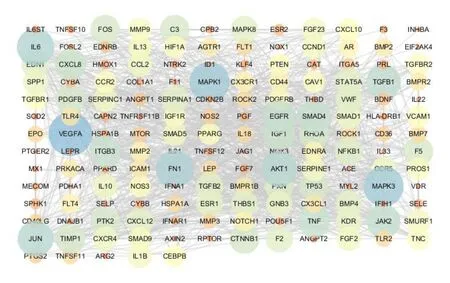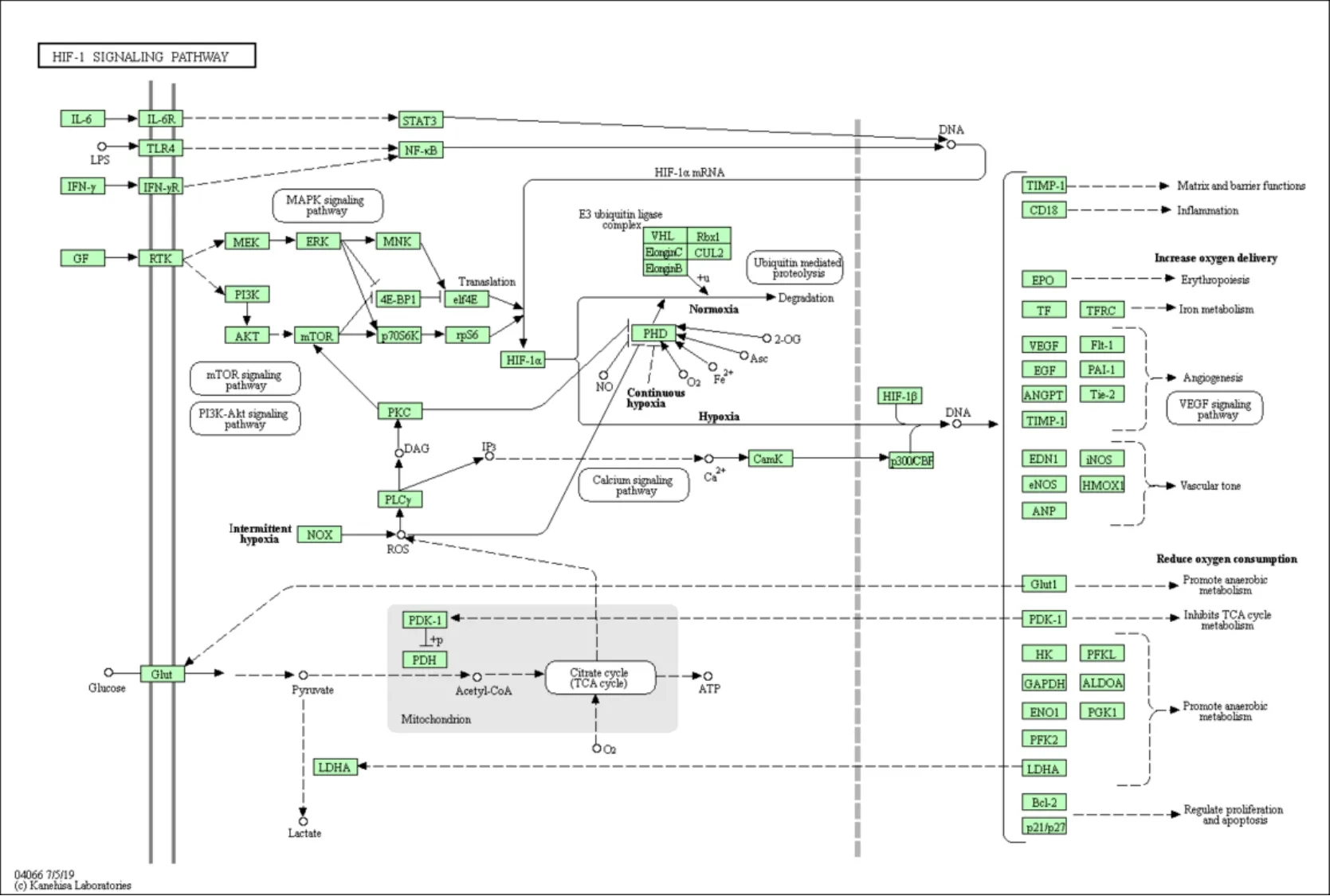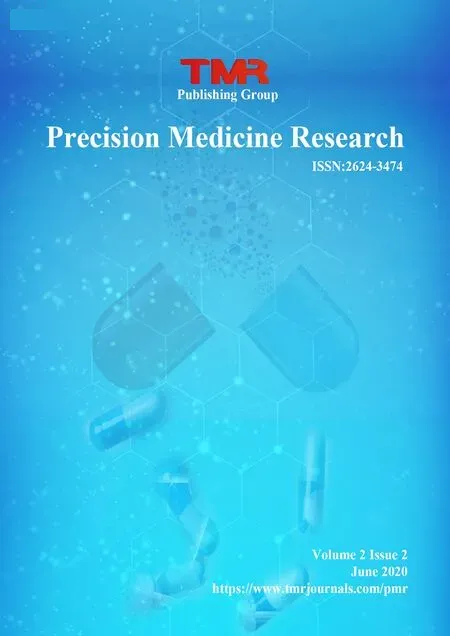Screening key target genes for pulmonary arterial hypertension based on bioinformatics
Zhi-Hua Yang, Ting-Ting Lv, Hai-Feng Yan, Lin-Wang, Yi-hua Fan
1First Teaching Hospital of Tianjin University of Traditional Chinese Medicine, Tianjin 300381, China.
2Jiangsu College of Nursing, Huaian 475300, China.
Abstract
Background: Screening key target genes for pulmonary arterial hypertension (PAH) based on bioinformatics to provide a reference for the clinical development of drugs to cure PAH. Methods: The keyword “pulmonary arterial hypertension” was used to search related genes in the National Center for Biotechnology Information database(NCBI). The obtained genes data was input to the database of Database for Annotation, Visualization and Integrated Discovery (DAVID) (Version 6.8) to collect relevant information about pathways and genes. And the data of genes were enriched in 37 pathways and genes with occurrence frequency ≥ 10 were respectively imported into the String database to construct protein-protein interaction (PPI) network diagrams, and the two network diagrams were compared. Results: VEGFA, MAPK1, MAPK3, IL6, JUN and TNF were among the highest-ranked genes in two network diagrams. Conclusion: The pathogenesis of PAH is associated with multiple pathways such as the TGF-β signaling pathway, PI3K-Akt signaling pathway, MAPK signaling pathway, HIF-1 signaling pathway and so on. The study of VEGFA, MAPK1, MAPK3, IL6, JUN and TNF are closely related to PAH is necessary for us to study further.Through gene interaction network and pathway analysis of disease-associated genes, which will help us to screen the critical target genes of PAH and provide a reference for clinical development of effective drugs for PAH.
Keywords: Bioinformatics, Pulmonary arterial hypertension, Target genes
Background
Pulmonary arterial hypertension (PAH) is a rare and poor prognosis progressive disease, which is characterized by increased pulmonary vascular resistance and continuous increase of pulmonary vascular pressure. The outcome is right heart failure and premature death [1]. The pathogenesis of PAH is complex, but it has similar pathophysiological changes.For instance, the increase of pulmonary artery contractility, endothelial dysfunction, remodeling and proliferation of endothelial cells and smooth muscle cells, and the formation of thrombus in situ [2]. At present, it is believed that pulmonary artery remodeling is the most critical pathological change, which can lead to the pulmonary artery and right ventricular disease,and eventually lead to right heart function decline or even death [3]. The survey shows that about 1% of the world's population is affected by PAH. The incidence rate of people over 65 years old is 5% to 10%, and the incidence rate of females is higher than that of men [4].At present, drug therapy for remodeling the structure and improving the function of the pulmonary artery is mainly based on the following two strategies: ①targeting the process of pulmonary vasoconstriction,promoting pulmonary vasodilation, ② targeting the process of pulmonary vascular reconstruction,inhibiting pulmonary vascular endothelial cells proliferation [3]. Because PAH targeted drugs can only alleviate the symptoms of patients with PAH, and the curative effect and prognosis effect are limited, So that the life span of patients with PAH is short, and patients are prone to drug resistance. At present, there is no specific drug for PAH treatment, mainly because the pathogenesis of the disease is very complex, and there is no suitable target for targeted therapy. This study combines bioinformatics and gene interaction networks for comprehensive analysis to identify possible drug targets for PAH and provide reliable targets for new drug development.
Research methods
Collecting PAH related genes
The database of National Center for Biotechnology Information (NCBI) (http://www.ncbi.nlm.nih.gov/) is an automatic system database for the storage and analysis of knowledge about molecular biology,biochemistry and genetics. Three hundred and twentyfive PAH genes were identified using the NCBI database.
Analysis of PAH related pathways with DAVID tool
The Database for Annotation, Visualization and Integrated Discovery (DAVID) is an online database of gene and pathway function annotation [5]. In this paper,DAVID (version 6.8) was used to analyze the pathway of PAH related targets. According to the false discovery rate (FDR < 0.01) as the screening criteria, the vital signal pathways were selected for key analysis.
Operation steps of DAVID database
Import the 325 PAH related genes screened into the DAVID database for analysis. The specific steps are as follows: step 1, enter the homepage of the DAVID database, click “function annotation”; step 2, input 325 PAH related genes to be analyzed in the enter gene list;step 3, select “ENTREZ_GENE_ID” in the select identifier, step 4, select “gene list”; step 5, click “submit list”; step 6, click “background” and select “Homo sapiens”; step 7, click “list” and select “Homo sapiens”.
Interaction network analysis of genes significantly enriched in pathways
According to the results of DAVID database analysis,genes enriched in pathways and genes appearing on the pathway with frequency ≥ 10 were input into the STRING database (http://string-db.org/) to construct protein-protein interaction network model, and the species was set as “Homo sapiens” [6, 7]. The minimum protein interaction threshold was set to “highest confidence” ( > 0.9). The protein interaction was screened, the results were saved in TSV format, and the node1, node2, and combined score data in the file were retained and imported into Cytoscape 3.5.1 software for analysis of gene interaction network diagrams. The specific operation is as follows. (Cytoscape → tools →network analyzer → network analysis → analyze network), save the network analysis results, and use the generate style from statistics tool (Cytoscape → tools→ network analyzer → network analysis → generate style from Statistics). Degrees of freedom and betweenness are two main topological parameters that measure the importance of a node in the network. They are also relevant references for determining whether a gene is a “core target” (the greater the degree of freedom, the stronger the biological importance, and the greater the betweenness, the more important the node is in the network) [8]. The size of a node is determined by the degree of freedom (the greater the degree of freedom, the larger the node). The color of the node is set according to the degree of freedom, and the degree of freedom gradually increases as the color changes from red to blue. The thickness of the edge is determined by the betweenness, and the larger the betweenness, the thicker the edge. Compare the total gene network map enriched in the pathway with the gene network map with the frequency of 10 or more to find out the genes that are shared by the two and have the highest degree of value, These genes may be the key target genes to regulate the pathogenesis of PAH.

Table 1 Top 37 pathways with significant enrichment
Results
DAVID pathway analysis
In the DAVID database, 325 related genes were input and their Kyoto Encyclopedia of Genes and Genomes(KEGG) pathways were analyzed and 322 genes were enriched in 107 pathways. Based on FDR < 0.01 as the screening condition, 37 pathways were screened and 193 genes were annotated on these pathways (Table 1).Twenty-two genes were annotated on 37 pathways with frequency ≥ 10 (Table 2).

Table 2 Genes with a frequency of ≥ 10 in 37 pathways significantly enriched

Figure 1 Network diagram of 193 gene interactions
Network analysis of genes enriched in pathways and high-frequency genes
A total of 193 PAH related genes were significantly enriched in the first 37 pathways, and 22 genes appeared in 37 pathways with a frequency of ≥ 10.These 22 genes may be closely related to the pathogenesis of PAH, because they are involved in the signaling of multiple pathways. To study the interaction between genes, 87 genes and 16 genes with high frequency were input into the String database to make the network map of gene interaction. Figure 1 is the 193 genes enriched in 37 pathways (32 genes are not shown),and Figure 2 is the 22 genes with a frequency of ≥ 10 in 37 pathways. The genes with the highest degrees of nodes in the two graphs may be the target genes. There are 161 nodes and 891 interactions, with an average value of 11.068 (Figure 1). There are 22 nodes and 95 interactions, with an average value of 8.636 (Figure 2).Six genes are highly ranked in the two figures,includingVEGFA,MAPK1,MAPK3,IL6,JUNandTNF,indicating that these six genes are strictly related to PAH and should be our target genes for PAH research.

Figure 2 Network diagram of 22 gene interactions

Figure 6 HIF-1 signaling pathway
Discussion
PAH is a fatal disease with complex pathogenesis and it is one of the chronic cardiovascular diseases that are difficult to cure nowadays. Its typical pathological change is pulmonary artery remodeling, which leads to the increase of pulmonary artery pressure, pulmonary vascular resistance, and finally lead to right heart failure[9]. At present, there are no clinically effective drugs to cure the disease, and most of the drugs are just to relieve symptoms. It is urgent to develop effective drug targets and corresponding drugs. In this study, we aimed to find out the key target genes and related signaling pathways involved.
In this study, the NCBI database was used to identify key genes related to PAH and finally 325 genes were selected. The KEGG pathway enrichment analysis of these genes was performed using the DAVID database.We found a total of 193 PAH related genes were significantly enriched in 37 pathways, and 22 genes appeared in 37 pathways with a frequency of ≥ 10. We made a network diagram to find the interaction between 193 and 22 PAH related genes through the String database. We found thatVEGFA,MAPK1,MAPK3,IL6,JUNandTNFare higher in the two network diagrams than other genes, indicating that they are closely related to PAH. Vascular endothelial growth factor may induce fibroblast proliferation and promote neovascularization,which is closely related to chronic airway inflammation and pulmonary vascular remodeling, and ultimately leads to the formation of secondary PAH [10]. Besides,it was found that the levels of platelet-derived growth factor and its tyrosine kinase receptor were increased in the lungs of PAH patients, and the levels of vascular endothelial growth factor were also increased in the lungs of PAH patients [11]. Tumor necrosis factor-α(TNF-α) is an inducible factor of inflammation, which mediates and regulates the structural reconstruction of pulmonary vessels [12]. TNF-α may not only downregulate the expression of bone morphogenetic protein 6 in pulmonary arterial smooth muscle cells, and inhibit the notch 3-hairy and enhancer of split 1 signaling pathway, but also promote the proliferation of pulmonary arterial smooth muscle cells and induce the occurrence of pulmonary vascular remodeling. Animal experiments have confirmed that the expression of TNF-α in transgenic mice with severe PAH increased,suggesting that tumor necrosis factor-α is of great significance in the pathogenesis of PAH [13]. In recent years, studies have shown that interleukin-6 (IL-6) is involved in the formation of chronic obstructive pulmonary disease complicated with pulmonary hypertension. IL-6 may regulate the reconstruction of the pulmonary vascular structure. Meanwhile, IL-6 may change the permeability of vascular endothelial cells,which is related to the increase of collagen in the vascular wall during the occurrence of hypoxic PAH[14]. Wang et al. found that the expression of IL-6 mRNA and protein increased in the lung tissue of rats with hypoxic PAH, indicating that IL-6 pathway is involved in the pathogenesis of hypoxic pulmonary hypertension [15]. In the Signaling pathways related to PAH, transforming growth factor-β1 (TGF-β1)signaling pathway may be an important pathogenesis of PAH. TGF-β family is a group of growth factors that are widely expressed in the body and play an important role in maintaining homeostasis and immune system [17].There is a close relationship between the formation and development of PAH and the members of TGF-β superfamily. The signal pathway involved in TGF-β is involved in the disease process of PAH [18]. TGF-β1 promotes smooth muscle cell proliferation,extracellular matrix deposition and endovascular to mesenchymal transition (EndMT) by regulating a variety of signaling pathways, resulting in pulmonary artery remodeling and eventually PAH. The role of TGF-β1 in the development of PAH provides potential drug targets and new strategies for the treatment of PAH(Figure 3). Phosphoinositide 3-kinase/ protein kinase B(PI3K-Akt) signaling pathway can regulate cell growth,metabolism, apoptosis and other activities, and has a wide range of biological effects [19]. Under the condition of hypoxia, the platelet-derived growth factor can activate the PI3K-Akt signal pathway and promote the proliferation as well as migration and redifferentiation of pulmonary artery smooth muscle cells, resulting in pulmonary vascular remodeling [20].Another study found that bone morphogenetic protein-4 (BMP4) can promote Akt phosphorylation and activate PI3K-Akt signaling pathway, as well upregulate the expression of p-smad1/5/protein and downregulate the expression of the caspase-3 protein, inhibits the apoptosis of pulmonary artery smooth muscle cells(PASMCs), and induce pulmonary artery remodeling in rats with PAH (Figure 4) [21]. Mitogen-activated protein kinase (MAPK) signaling pathway is a highly related protein kinase superfamily of serine/ threonine kinases, including extracellular regulated protein kinases (ERK1/2) and p38 mitogen-activated protein kinase, et al. ERK1/2 is a kind of silk/threonine protein kinase, which can transmit the mitogen signal [22].Under the condition of hypoxia, the study found that endothelin-1 (ET-1) can promote the phosphorylation of ERK1/2 and activate MAPK signaling pathway, and well increase the expression of c-jun and c-fos protein and induce the phosphorylation of c-jun and c-fos,which leads to the proliferation of PASMCs [23].Besides, insulin-like growth factor-1 (IGF-1) can phosphorylate p38 MAPK and promote the expression of inducible NOS (iNOS) protein, and inhibit the apoptosis of PASMCs by activating p38 MAPK iNOS signal transduction pathway (Figure 5) [24]. The study found that the hypoxia-inducible factor-1 (HIF-1)overexpression can be detected by induced PAH disease model under the condition of hypoxia, suggesting that HIF-1 plays an important role in PAH [25]. Hypoxiainducible factors family (HIFs) is the main regulator of the body in response to the hypoxia environment. They are related to hypoxia-induced lung tissue cell injury and abnormal proliferation. HIF-1α and HIF-1β are the two subunits of HIFs. HIF-1α, as the main factor of homeostasis regulation of oxygen content in the body,can activate its target gene such as inducible type through transcription iNOS, ET-1 and VEGFA affect the pathogenesis and progress of PAH [26]. It has been shown that knockout of HIF-1α gene in rats can reduce pulmonary vascular remodeling and the incidence of PAH (Figure 6) [27].
In this study, we explored target genes that are closely related to PAH through various aspects such as the analysis of KEGG pathway enrichment, gene function,gene interaction network by using bioinformatics.Finally, we found thatVEGFA,MAPK1,MAPK3,IL6,JUNandTNFare closely related to PAH. These six genes may be the important target genes of PAH,providing a reference for clinical research and the development of effective drugs for PAH treatment.
 Precision Medicine Research2020年2期
Precision Medicine Research2020年2期
- Precision Medicine Research的其它文章
- Screening key target genes for severe acute respiratory syndrome coronavirus 2(SARS-CoV-2) based on bioinformatics and gene network
- A network pharmacology approach to investigate the mechanism of “Huangqi-Shanzhuyu” in the treatment of diabetic nephropathy
- Network pharmacological approach to explore the mechanisms of Lianhua Qingwen capsule in coronavirus disease 2019
- Use of network pharmacology and molecular docking to explore the potential mechanism governing the efficacy of Jinhuaqinggan granules in the treatment of novel coronavirus-induced pneumonia
